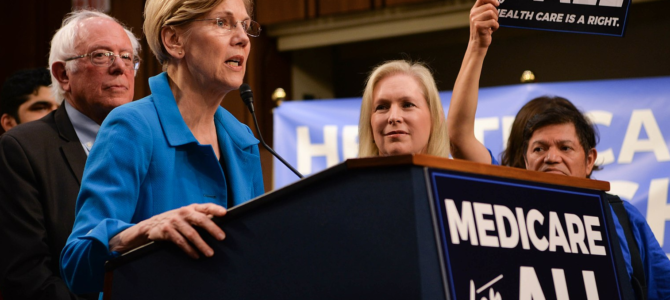
England’s single-payer health-care system, National Health Service (NHS), has released another report documenting its repeated failures to provide timely care. Delays before seeing a physician have increased, wait times in emergency rooms have lengthened, and most ominous, Britons who could have been saved if they had received care in time are dying from cancer.
Despite this damning evidence from the NHS and ominous projections for Medicare-for-all in the United States, the American left continues to push a single-payer plan. Yes, Americans are frustrated with the current unaffordable, inaccessible health-care system. Nobody has presented a viable alternative. It’s time to correct this deficiency — but single-payer is exactly the wrong way to do so.
Eschew Medicare-for-All
Americans should reject Medicare-for-all for numerous reasons: Washington’s track record, single-payer failures in other countries, false advertising, cost, and — most important — access to timely care.
Medicare-for-all, like Obamacare but more far-reaching, is another Washington “fix” for health care. Those very fixes brought us to this point: People can’t get care, can’t pay for insurance, and the country is spending money it doesn’t have. Washington’s track record is one of unfulfilled promises and fixes that fail or backfire.
“Medicare-for-all” is false advertising, a form of bait-and-switch. The title implies Washington will expand the current medical program for retired workers to include all Americans. Yet Section 901(a)(1)(A) of the Medicare for All Act of 2019, H.R. 1384, abolishes the entire Medicare program, and Section 701(d) liquidates the Medicare Trust Fund. One cannot expand a program that has no money and doesn’t exist.
Recall the discussions in the run-up to passage of the Affordable Care Act. President Obama repeatedly said we had to reduce health-care spending because the trend line was “unsustainable.” Medicare-for-all will cost $32 trillion, $40 trillion, or even $52 trillion.
For a sense of perspective, the combined gross domestic product of all nations on Earth is $87 trillion. Democrats propose spending 60 percent of that amount on the first ten years of their single-payer Medicare-for-all.
U.S. health-care spending is notoriously dollar inefficient, as less money goes to care and more goes to bureaucracy. At least 31 percent of the $3.6 trillion spent on health care in 2018 went to federal administration, bureaucracy, regulation, and compliance, thus depriving the American people of $1.116 trillion worth of patient care.
While cost alone should be sufficient to scuttle Medicare-for-all permanently, there is a more compelling reason: It will also reduce people’s access to care. Medicare-for-all simultaneously eliminates private insurance (Section 107) and cuts reimbursement schedules (Section 611). Payments to providers and hospitals will be less than their cost of doing business. This means there will be fewer doctors and medical facilities.
Before Obamacare, average maximum wait time to see a primary care doctor was 100 days. The ACA increased the wait to 176 days. With Medicare-for-all, the wait could be — like the VA and the NHS — years! With Medicare-for-all, people who could be saved will die waiting in line for care.
Embrace Market-Based Medicine and StatesCare
To cure a patient, one must treat the cause of illness. For health care, the cause of system failure is the combination of third-party payment with federal control.
As federal control is a root cause, Washington should be removed from health care. This is called StatesCare, returning authority where it belongs per the Constitution. The 10th Amendment reserves “power” in health care “to the states respectively, or to the people.”
The people in their states should be free to choose whatever health-care structure they believe will best satisfy their local medical needs within the state’s unique resource and financial constraints. Based on all the evidence and financial modeling, their best choice would be market-based medicine.
Market-based medicine eliminates the third party as a decision-maker and thus reconnects patients with doctors. Patients can shop for their care and can afford to pay out of large family HSAs for all care except unexpected medical disasters, for which they would have high-deductible catastrophic insurance. Sellers compete on price and quality for buyers’ dollars, not for contracts as they do now.
Reconnecting buyers directly with sellers — cutting out a third-party payer — restores the two key market forces to health care: the need of buyers (patients) to economize, and competition among sellers. States, not Washington, can and probably will construct safety nets for those they define as medically vulnerable. Models of both high-risk pools and state-supported HSAs can work well so those at risk will not be denied needed care.
Americans are profoundly frustrated with health care. Before the ACA, health care didn’t work and was too costly. Obamacare made health care more expensive and less responsive. Medicare-for-all will crash the system. Although Americans see no viable alternative, there is a good two-step solution.
First, get out from under federal domination. Implement StatesCare and let “we the people” decide health care more locally. If Californians want single-payer, if Oregonians want universal health care, and if Texans wants market-based care, they all should be free to decide their own fate without federal interference.
Second, Americans should consider market-based medicine as a viable option for their choice of health care.









